![]()
![]()
![]()
Use LEFT and RIGHT arrow keys to navigate between flashcards;
Use UP and DOWN arrow keys to flip the card;
H to show hint;
A reads text to speech;
17 Cards in this Set
- Front
- Back
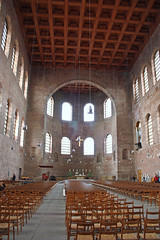
Aula Palatina -Germany / Late Antique Europe - early 4th century C.E.
Content -early christian church
Style -main central area . . . nave -semi circular apse with half dome . . . coffered ceiling -high ceilings -roman arch |
This early Christian church is the link between the true roman basilica and the true christian church. It adopts some Roman concepts, like the dome, high ceilings, and a coffered ceiling. The church was open to all, not restricted like roman temples. |
|

48. Catacomb of Priscilla - Rome, Italy / Late Antique Europe - c. 200–400 C.E.
Content -christian burial -40000 tombs -earliest christian art
Style -hand-carved . . . soft stone material -plastered . . . buon fresco -tried to reproduce look of natural stone -bodies were placed in recessed areas . . . the bigger the more important (to fit tombs) -spaces were covered with painted plaster
|
The catacombs of Priscilla offer a glimpse into the earliest of Christian iconography and symbols from the frescoes covering the walls. The bodies that were buried here were taken out by early Christians, because some of the bodies belonged to martyrs that had been persecuted for being catholics. The martyrs were then made into saints. |
|
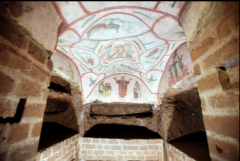
48. Greek Chapel, Catacomb of Priscilla - Rome, Italy / Late Antique Europe - c. 200–400 C.E.
Content -in the Catacombs of Priscilla -was not a chapel, or greek - just has greek lettering
Style -has greek letters -plaster built up and then painted to look like marble platforms |
The Greek Chapel, which is not really Greek or a chapel, has a ceiling full of some of the first Christian iconography, including the Orant Fresco and the Good Shepard Fresco. |
|
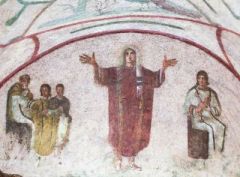
48. Orant Fresco, Catacomb of Priscilla - Rome, Italy / Late Antique Europe - c. 200–400 C.E.
Content -same woman depicted three times: marriage, motherhood, praying
Style -shadow creates depth -too large of hands for body |
This fresco, depicting the same woman in three different positions, represents the hope of her family that she would enjoy a blessed afterlife.
|
|

48. Good Shepherd Fresco, Catacomb of Priscilla - Rome, Italy / Late Antique Europe - c. 200–400 C.E.
Content -young shepherd christ surrounded by three goats -birds . . .quails, doves
Style -ground mineral plaster -contrapposto -symmetric |
This fresco, in the center of the Greek Chapel's ceiling, shows that christ will care for his followers like a good shepherd cares for flock.
|
|
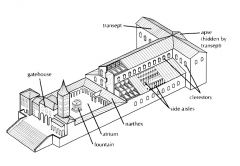
Old St. Peter’s Basilica - Rome, Italy / Late Antique Europe - early 4th century CE
Content -no longer exists, was where the new St. Peter's Basilica is now
Style -stone and cocrete walls with wooden roof -the layout is a cross -transept is the cross piece -large central nave -side aisles along nave, collenaded -clerestory . . . elevated ceiling above nave with windows to let in light -narthex . . . covered entrance . . . related to portico -atrium with fountain |
After the fall of Rome, the Old St. Peter's Basilica, like many Roman buildings, were pillaged for materials. The new St. Peter's Basilica was built on top of this one. |
|
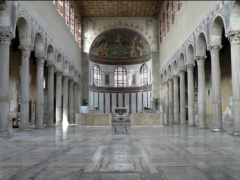
49. Santa Sabina - Rome, Italy / Late Antique Europe - c. 422–432 C.E.
Content -early Christian church
Style -ancient roman tradition of the basilica -apse -side aisles divided by row of corinthian colonnade supporting round arches -flat roof -lack of decoration, spare -clerestory (not real glass) -fresco above apse
|
Santa Sabina was built 110 years after Constantine made christianity legal. It was an early Christian church built in the Roman basilica style. However, rather than using the basilica as a meeting place, it is used here as a sacred space. The church was open to everyone rather than just a select few, and that fact alone separates christian churches from other ancient religious buildings. |
|
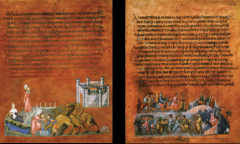
50. Rebecca and Eliezer at the Well and Jacob Wrestling the Angel, from the Vienna Genesis - Early Byzantine Europe - Early sixth century C.E.
Content -early manuscript -manuscript of first bible book -illustrations at bottom of each page
Style -made from animal skin -handwritten text -text written in silver originally -parchment dyed purple -classical relief bent in middle (to fit size of book), if straightened would be a frieze -roman appropriation
|
These are pages from an illuminated manuscript, and one of the first versions of the bible. These particular pages depict the story of Jacob from the bible. |
|
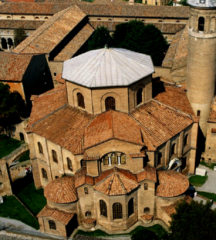
51. San Vitale - Ravenna, Italy / Early Byzantine Europe - c. 526–547 C.E.
Content -early byzantine Christian church
Style -centrally planned -octogonal -bricks taken from ancient roman buildings -stacking columns -ambulatory / gallery above -completely covered in mosaics -columns leave classical orders -impost blocks between columns and arches -cloisters . . . .colonnaded walkways outside -apse |
San Vitale is one of the most important surviving examples of Byzantine architecture and mosaic work. It was an early christian church and was one of the first centrally planned churches. |
|
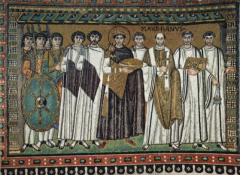
51. Justinian Panel, San Vitale - Ravenna, Italy / EarlyByzantine Europe - c. 526–547 C.E.
Content -to the left of the apse -mosaic -wearing the royal purple -surrounded by court, clergy members, soldiers - holding a bowl that would have contained the holy bread
Style -mosaic -small pieces of colored glass with gold leaf set into wall at angles to reflect light, creates liveliness -some figures are more individualized than others -halo around Justinian's head -Justinian is central -stylized -not accurate proportions |
Justinian and Theodora were emperor and empress. The insertion of their mosaics in San Vitale reasserted their power over the city of Ravenna. However, interestingly enough, they were ruling from Constantinople, which proves how influential their rule was. Additionally, their mosaics being placed on either side of the apse raises their level of rule to god-like or close to it. |
|
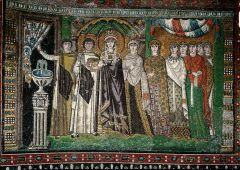
51. Theodora Panel, San Vitale - Ravenna, Italy / Early Byzantine Europe - c. 526–547 C.E.
Content -to the right of the apse -mosaic -very similar to the justinian panel -wearing incredibly elaborate byzantine clothing -cup for holy wine -surrounded by attendants
Style -mosaic -small pieces of colored glass with gold leaf set into wall at angles to reflect light, creates liveliness -some figures are more individualized than others -halo around her head -Theodora is central -stylized -not accurate proportions
|
Justinian and Theodora were emperor and empress. Theodora is depicted so similarly and elaborately to Justinian that they seem to be regarded as co equals. The insertion of their mosaics in San Vitale reasserted their power over the city of Ravenna. However, interestingly enough, they were ruling from Constantinople, which proves how influential their rule was. Additionally, their mosaics being placed on either side of the apse raises their level of rule to god-like or close to it. |
|

52. Hagia Sophia - Constantinople (Istanbul) / Anthemius of Tralles and Isidorus of Miletus - 532–537 C.E.
Content -red part is the early Christian Church -roman, christian, islamic imagery
Style -central plan -massive central dome . . .182 ft tall from floor level -clerestory windows -dome rests on square drum -symmetrical (both ways pretty much) -apse -lavishly decorated, with frescos and mosaics throughout -colonnades -pendentives (curved vaulting between the dome and its supporting arches) support wieight of dome
|
This piece was first a christian church, then an islamic mosque, an now a secular site. It set the tone for architecture in the Eastern Roman Empire. The building itself was a new innovation with a dome upon a square and repeated half domes around it. It has undergone several transformations and additions by the various groups associated with it to get where it is today. |
|
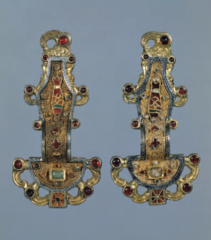
53. Merovingian looped fibula -Early medieval Europe - Mid-sixth century C.E.
Content -clasps, hold garments together
Style -gold, garnets & other stones -ornate decorations -zoomorphic imagery (animals) . . . . eagles, fish -linear intertwining designs -return to stylization from naturalistic, classical realism |
Each one of the looped fibula was a clasp that held the traditional garment together at the shoulder. They quickly became status symbols with their use of precious stones. During this time, artists were not focused on creating beauty by way of realism like they had been in classical, southern Europe. |
|
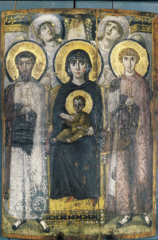
54. Virgin (Theotokos) and Child between Saints Theodore and George - Early Byzantine Europe - 6th or early 7th century C.E.
Content -typical byzantine image of Virgin Mary and Christ
Style -fresco -golden halos communicate holiness -stylized faces (football shaped eyes, browline) -dangling feet at odd angles -robes hide figures -certain hand positions -christ depicted as toddler that looks like an older man |
Leo the third thought god was punishing the Christian empire for worshipping icons so much, and banned icons in art, starting a controversy between iconoclasts and iconophiles. The iconoclasts covered and destroyed many of the early Christian imagery in churches such as the Hagia Sophia. People questioned wether Christians should worship visual representations of holy figures, or if that was false worship. The idea that it was false worship dominated for a while. Afterwards, they returned back to the depiction of the human form, but they lost technique and realism and became more symbolic figures. People at the time were not concerned with the beauty of the world like in the classical times. |
|
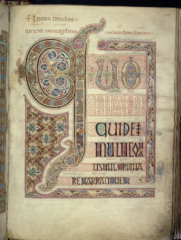
55. Lindisfarne Gospels: St. Matthew, cross-carpet page, St. Luke portrait page, St. Luke incipit page - Early medieval Europe / (Hiberno Saxon) - c. 700 C.E.
Content -hiberno-saxons, anglo-saxons, vikings -cover page, inner pages -illuminated manuscripts -original bibles
Style -animal hide -painted and caligraphy -colored inks, gold leaf -interlacing vine-like style -influenced by islamic rugs -image of cross -zoomorphic imagery |
Illuminated manuscripts like this were created in scriptorium rooms in monasteries by monks. They had to appeal to both the non literate and the literate people, and therefore were covered in illustrations. The carpet-like over pages were almost acknowledgments to the similarities between Christian and Islamic churches. |
|
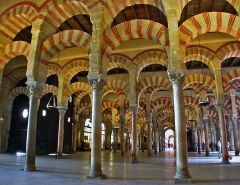
56. Great Mosque - Córdoba, Spain / Umayyad Dynasty - c. 785–786 C.E.
Content -early christian church in center of mosque -mosque built around church after islamic conquer
Style
|
. |
|

56. Great Mosque Plan - Córdoba, Spain / Umayyad Dynasty - c. 785–786 C.E.
Content
Style |
. |

